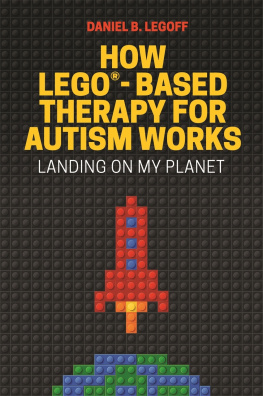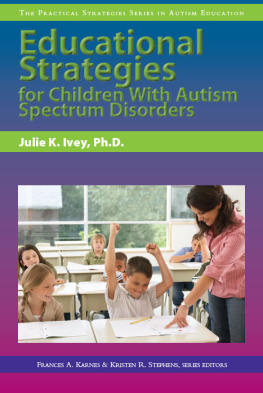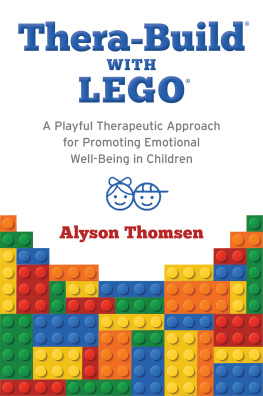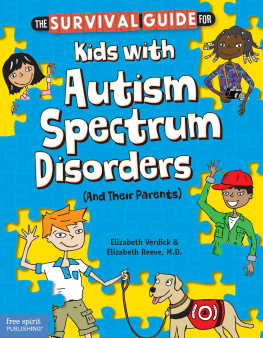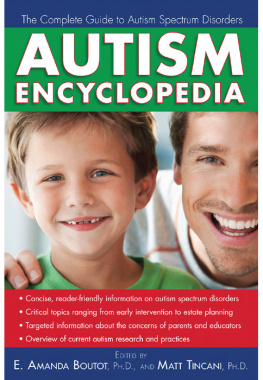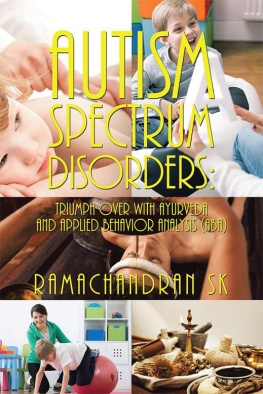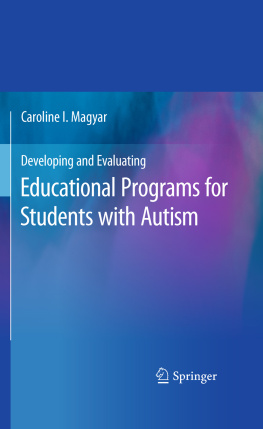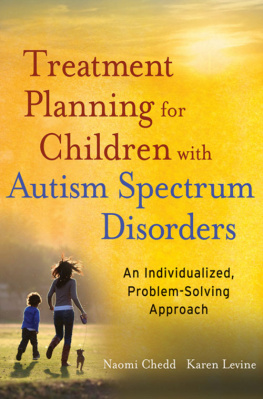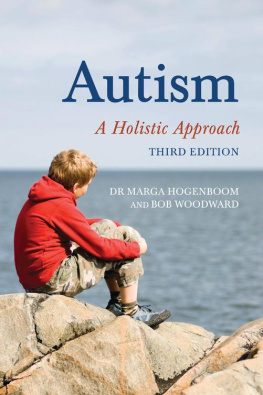
Daniel B. LeGoff, the inventor of LEGO-based therapy, has provided a colourful set of case studies to help teachers and clinicians get a real feel for how to implement this playful and non-stigmatizing intervention with kids with autism. LEGO-based therapy harnesses their strong drive to systemise to help them learn how to socialise. It is also intrinsically rewarding for such kids. As such, it is a pleasurable experience for both the therapist and the child.
Professor Simon Baron-Cohen,
Director, Autism Research Centre, Cambridge University, UK
by the same author
LEGO-Based Therapy
How to build social competence through LEGO-based Clubs for children with autism and related conditions
Daniel B. LeGoff, Gina Gmez de la Cuesta, GW Krauss, and Simon Baron-Cohen
ISBN 978 1 84905 537 6
eISBN 978 0 85700 960 9
of related interest
Building Language Using LEGO Bricks
A Practical Guide
Dawn Ralph and Jacqui Rochester
Foreword by Gina Gmez de la Cuesta
ISBN 978 1 78592 061 5
eISBN 978 1 78450 317 8
HOW
LEGO-BASED
THERAPY FOR
AUTISM WORKS
LANDING ON MY PLANET
DANIEL B. LEGOFF

Jessica Kingsley Publishers
London and Philadelphia
First published in 2017
by Jessica Kingsley Publishers
73 Collier Street
London N1 9BE, UK
and
400 Market Street, Suite 400
Philadelphia, PA 19106, USA
www.jkp.com
Copyright Daniel B. LeGoff 2017
All rights reserved. No part of this publication may be reproduced in any material form (including photocopying, storing in any medium by electronic means or transmitting) without the written permission of the copyright owner except in accordance with the provisions of the law or under terms of a licence issued in the UK by the Copyright Licensing Agency Ltd (www.cla.co.uk) or in overseas territories by the relevant reproduction rights organisation (for details see www.ifrro.org). Applications for the copyright owners written permission to reproduce any part of this publication should be addressed to the publisher.
Warning: The doing of an unauthorised act in relation to a copyright work may result in both a civil claim for damages and criminal prosecution.
Library of Congress Cataloging in Publication Data
A CIP catalog record for this book is available from the Library of Congress
British Library Cataloguing in Publication Data
A CIP catalogue record for this book is available from the British Library
ISBN 978 1 78592 710 2
eISBN 978 1 78450 290 4
DISCLAIMER
LEGO, the LEGO logo, the Brick and Knob configurations and the Minifigure are trademarks of the LEGO Group, which does not sponsor, authorize or endorse this book.
CONTENTS
INTRODUCTION
After the release of the LEGO-based therapy manual a few years ago (LeGoff et al. 2014), the main reason for following up with this book was to provide anyone interested in this therapy more of the clinical and anecdotal background details that led up to the final form of LEGO-based therapy. This is the story behind the data and methodology. The treatment manual was developed to establish that there was a method involved in running LEGO-based therapy groups, and that this method was both effective in improving social and communication skills in children and adolescents with autistic conditions, and that it was replicable. My experience with these groups started in the mid-1990s, well before the publication of the first outcome study (LeGoff 2004), and that history has not been described anywhere in the literature on LEGO-based therapy. I have previously written that there was no theoretical rationale or framework that led to the use of LEGO as a therapy tool for the treatment of autism. LEGO-based therapy was not based on a specific body of research literature or a particular theory about autistic conditions. It was a treatment developed by the children themselves. I wouldnt even call myself a facilitator, except that I paid for the LEGO and the space that allowed this to happen.
With the manual, I had more than mixed feelings. I resisted it. I just wanted to give the kids LEGO and a place to meet where they could communicate and socialize. I didnt want to have a bunch of therapists interfering. The core concept was so simple and straightforward it seemed like no one would need a manual. Get children who have autism and enjoy LEGO together and offer them LEGO-based activities which require interaction and collaboration. Thats it. With some coaching from the sidelines, they engaged in their own therapy. The effect was like an emergent property: hydrogen and oxygen alone do not predict the properties of water. Autism and LEGO do not predict what happened in my office. In reviewing the process, there did seem to be some details that needed explicating.
One of the issues I wanted to emphasize in writing this book was the unique qualities, personalities, life-stories and creative genius of the participants. As with all children today who carry a diagnosis of autism, knowing their diagnosis does not diminish their uniqueness or personality. Autistic characteristics are just features which can be more or less disabling, but which are embedded within unique and unpredictable personalities and life histories. It was the stories about uniqueness and creativity which were missing from the manual, and in the end, it was these childrens capacity for creativity that resulted in a successful treatment approach.
With regard to the designation of this population, which has undergone a number of changes from Kanner to Asperger to the Diagnostic and Statistical Manual of Mental Disorders (DSM) and then the International Statistical Classification of Diseases and Related Health Problems (ICD) theyve labeled these kids everything except what they are: unique, brilliant, innovative. The Pervasive Developmental Disorder (PDD) category had been introduced as a diagnostic entity in the American Psychiatric Association (APA)s fourth edition of the Diagnostic and Statistical Manual of Mental Disorders (DSM-IV). The pervasive developmental disorders at that time also included Autistic Disorder, Retts Disorder, Disintegrative Disorder and the vaguely defined Pervasive Developmental Disorder, Not Otherwise Specified (PDD-NOS). Prior to the changes in the diagnostic criteria for autistic conditions, autism (or autistic psychopathy) was considered a rare and virtually untreatable condition. It had the ominous overtones of childhood schizophrenia. This negative profile and prognosis for autism was made even more terrifying to parents by the realities of the outcomes at that time: lifelong disability, institutionalization, impenetrable social aloofness, and unpredictable and often self-injurious behavior. Aspergers Disorder was a much more hopeful diagnosis, characterized by eccentricities, like collecting interesting things, and not being good at basketball or football, and not good at cocktail conversations. There were many difficult features, like the lack of empathy (if someone has a scientific definition of empathy, Im willing to hear about it), and the maddening lack of eye contact but these were trivial compared to the devastating impact of full syndrome Autistic Disorder, or the similarly severe Retts Disorder or Disintegrative Disorder.
There were immediate effects of expanding the autism diagnosis into a separate category and including the milder forms of Pervasive Developmental Disorders (PDD-NOS and Aspergers). These effects became even more evident with the introduction of the autism spectrum concept, which officially replaced Pervasive Developmental Disorders in the DSM-5 (APA 2013). The first impact was reflected in the epidemiology the incidence and prevalence rates of autistic conditions increased dramatically, from about one in 1000 children to closer to one in 100 a ten-fold increase over a period of about ten years. In other words, autism went from being a rare childhood disorder to being a household term, commonly referred to in the media as an epidemic, and spawning a massive healthcare and educational reform movement, in less than one generation.
Next page
